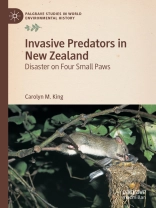The story of invasive species in New Zealand is unlike any other in the world. By the mid-thirteenth century, the main islands of the country were the last large landmasses on Earth to remain uninhabited by humans, or any other land mammals. New Zealand’s endemic fauna evolved in isolation until first Polynesians, and then Europeans, arrived with a host of companion animals such as rats and cats in tow. Well-equipped with teeth and claws, these small furry mammals, along with the later arrival of stoats and ferrets, have devastated the fragile populations of unique birds, lizards and insects. Carolyn M. King brings together the necessary historical analysis and recent ecological research to understand this long, slow tragedy. As a comprehensive historical perspective on the fate of an iconic endemic fauna, this book offers much-needed insight into one of New Zealand’s longest-running national crises.
Table des matières
I. The Years before Cook.- 1. Introduction (82 million years ago to AD 1280).- 2. The Māori Era (1280–1769).- II. The Years of Accidental Invasions.- 3. Reconstructing Invasion Histories from European Shipping Records (1769–1900) and Genetics (since 2000).- 4. European Rats (1769).- 5. House Mice (since about 1792).- 6. Cats (1769–1900).- III. The Years of Deliberate Introductions.- 7. Rabbits (1858–1900).- 8. Ferrets (1852–1892).- 9. Stoats and Weasels (1876–1883).- 10. Stoats and Weasels (1883–1892).- 11. Lucky Escapes and Nasty Surprises (1884–1920).- IV. What Now?.- 12. Hard Lessons in Pest Management (1976–2019).
A propos de l’auteur
Carolyn M. King is an international authority on the biology of mustelids and rodents. Her research experience ranges from native weasels at Oxford to introduced stoats, rats and mice in New Zealand, where official management of invasive predators has long been informed by her books, papers and university teaching.












